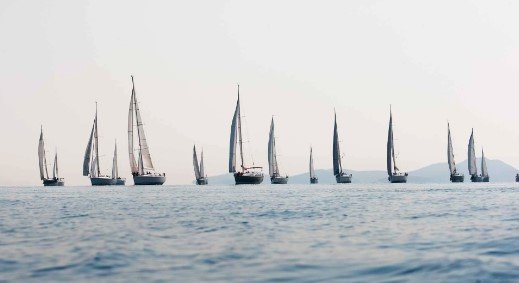Competitive sailing, a thrilling blend of sport, strategy, and skill, has captivated enthusiasts around the globe for centuries. From prestigious regattas to local club races, competitive sailing challenges sailors to push the boundaries of their expertise, navigate complex weather conditions, and master the art of teamwork. This article delves into the world of competitive sailing, exploring its history, key elements, and the strategies that make it a compelling and dynamic sport.

The History of Competitive Sailing
Competitive sailing has a rich history dating back to ancient times. The Greeks and Romans were among the first to engage in organized naval competitions, but it was during the 17th and 18th centuries that sailing evolved into a formal sport. The establishment of the America’s Cup in 1851 marked a significant milestone, setting the stage for international competition and the development of modern sailing techniques.
The America’s Cup
Often considered the most prestigious trophy in sailing, the America’s Cup is a symbol of excellence and innovation. The competition began with the schooner America winning the first race in 1851, and since then, it has grown into a global event that attracts the best sailors and teams. The America’s Cup has driven advancements in sailing technology, with teams continually pushing the limits of design and performance.
Olympic Sailing
Sailing was first introduced to the Olympics in 1900, showcasing its importance as a competitive sport. The Olympic sailing events have evolved over time, with a range of classes and disciplines represented. Olympic sailing emphasizes versatility and skill, with competitors facing diverse conditions and challenges on a global stage.
Key Elements of Competitive Sailing
Competitive sailing is defined by several key elements that combine to create a challenging and exciting sport. These include boat types, race formats, and the essential skills required for success.
Boat Types and Classes
Sailing boats come in various types and classes, each designed for specific conditions and purposes. Key classes in competitive sailing include:
- Monohulls: Single-hulled boats like the J/70 and the TP52, known for their speed and agility.
- Catamarans: Multi-hulled boats such as the Nacra 17 and the AC75, which offer stability and impressive speed.
- Dinghies: Small, agile boats like the Laser and the 420, popular in Olympic and youth competitions.
Each class has its own set of rules and design specifications, influencing performance and strategy.
Race Formats
Competitive sailing races can vary widely in format, from short, intense sprints to long-distance offshore events. Common formats include:
- Fleet Racing: Multiple boats race together on a course with the goal of finishing first. This format requires strategic positioning and tactical decisions.
- Match Racing: Head-to-head competition between two boats, focusing on tactics and maneuvering. Match racing is often used in events like the America’s Cup.
- Offshore Racing: Long-distance races that test endurance and navigation skills, often spanning hundreds or thousands of miles.
Essential Skills and Strategies
Success in competitive sailing requires a combination of physical skills, technical knowledge, and strategic thinking. Key skills include:
- Tactical Awareness: Understanding wind patterns, currents, and competitors’ actions to make strategic decisions during a race.
- Boat Handling: Mastery of sail trimming, steering, and maneuvering to optimize performance.
- Teamwork: In many competitive sailing events, a crew works together to execute maneuvers and strategies. Effective communication and coordination are crucial.
Famous Regattas and Competitions
Several prestigious regattas and competitions are renowned for their intensity and significance in the world of competitive sailing.
The Volvo Ocean Race
Previously known as the Whitbread Round the World Race, the Volvo Ocean Race is a grueling offshore competition that takes teams around the globe. The race tests endurance, navigation skills, and teamwork over several months, with competitors facing extreme weather conditions and challenging seas.
The Sydney to Hobart Yacht Race
This annual race, held on Australia’s eastern coast, is famous for its challenging conditions and competitive field. Covering over 600 nautical miles, the Sydney to Hobart tests sailors’ skills and resilience in one of the world’s most iconic offshore races.
The Fastnet Race
A prominent offshore race starting in Cowes, England, the Fastnet Race is known for its unpredictable weather and challenging course. It attracts top sailors from around the world and is a key event in the offshore racing calendar.
The Future of Competitive Sailing
Competitive sailing continues to evolve, driven by technological advancements and growing interest in the sport. Innovations in boat design, materials, and technology are pushing the boundaries of performance, while initiatives to make the sport more inclusive and accessible are expanding its reach.
Technological Innovations
Modern sailing benefits from advancements in technology, including:
- Hydrofoils: Devices that lift the hull out of the water, reducing drag and increasing speed.
- Advanced Materials: Lightweight, durable materials that enhance performance and safety.
- Data Analytics: Systems that provide real-time data on boat performance, wind conditions, and race strategy.
Growing Participation
Efforts to make competitive sailing more accessible include youth programs, grassroots initiatives, and adaptive sailing opportunities. These programs aim to introduce more people to the sport and develop the next generation of sailors.
Conclusion
Competitive sailing is a sport that combines strategy, skill, and adventure. From the historic America’s Cup to modern technological advancements, sailing continues to captivate and challenge those who embrace its complexities. Whether participating in local regattas or global races, sailors navigate a dynamic and ever-evolving world, where precision and passion drive them toward victory. As the sport progresses, it will undoubtedly continue to inspire and engage sailors and enthusiasts around the globe.

